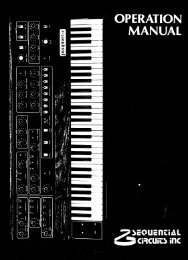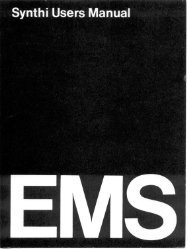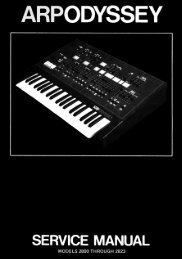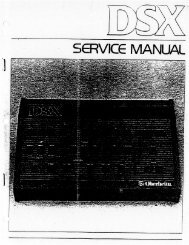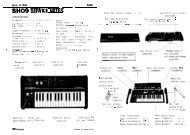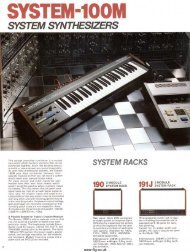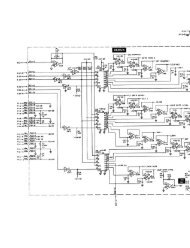ARP2600 - Fundamentals of Music Technology - Cyborgstudio.com
ARP2600 - Fundamentals of Music Technology - Cyborgstudio.com
ARP2600 - Fundamentals of Music Technology - Cyborgstudio.com
Create successful ePaper yourself
Turn your PDF publications into a flip-book with our unique Google optimized e-Paper software.
066 - SECTION EIGHT: THE VCAOF LAWSUITS AND PATENT INFRINGEMENT- PART IIMany <strong>of</strong> the modules studied thus far were developed by Bob Moog, and the VCA is no exception. It isinteresting to note that at the same time Dr. Moog was building his first VCA, Vladimir Ussachevskywas also designing a VCA. He shared his plans with Dr. Moog, only to discover that Dr. Moog hadalready designed and built his own VCA. However, the Moog VCAs did not have an exponentialoption at first. This requires the use <strong>of</strong> an electronic circuit called a linear to exponential converter.This circuit just turns linear signals into exponential ones, as the name implies. This circuit was designedby the ARP <strong>com</strong>pany, and it appeared on the gigantic ARP 2500 modular synthesizer.Before too long, the circuit also began appearing on Moog synthesizers without ARP’s permission.One may recall from Section 6 that ARP had infringed on Moog’s filter design patent, and that Moogmusic threatened to sue ARP if the design was not changed. ARP did change its filter design, but itneeded time to do so. They told Moog music in no uncertain words that if they sued ARP for infringement<strong>of</strong> the filter patent, that they would return fire with a lawsuit over the linear to exponential convertercircuit, which Moog <strong>Music</strong> actually continued to use until its demise.OTHER FUN THINGS TO DO WITH A VCASince there are two inputs on the VCA, it could really be used as a mixer, albeit a small one. Whatevertwo signals are fed into the VCA will be <strong>com</strong>bined together and appear at its output. One must again becareful <strong>of</strong> distortion, though. Typically, when two signals are used in the VCA, the levels must be seteven lower than when one signal is used.By controlling the VCA with a sine wave in LF mode, one can create the popular effect called tremolo.Tremolo is a constant change in volume and creates a wavy sound not dissimilar to vibrato. It is possibleto purchase a device which is a dedicated tremolo effect unit, and this is <strong>com</strong>mon in the world <strong>of</strong>electric guitars. These units simply contain a variable rate LFO which always produces a sine wavewhich in turn modulates a VCA. An example <strong>of</strong> tremolo can be heard on CD track 44.Users may be interested to note what occurs when the VCA’s gain is modulated quickly and deeplyenough by a VCO in LF mode: just like FM in the audio range, sidebands are produced. They sound abit different from their FM counterparts, but they are definitely sidebands, nonetheless. An example <strong>of</strong>these sidebands can be heard on CD track 45.Because <strong>of</strong> the flexible design which is employed in the ARP 2600, the VCA can be used to processcontrol signals as well as audio signals. In this respect, the VCA can be thought <strong>of</strong> as a voltage controlledattenuator for any in<strong>com</strong>ing signal. However, the VCA cannot simultaneously process bothaudio and control signals since they would be mixed together. When it is used to process controlsignals, the VCA cannot be used to process audio signals, which leaves the task <strong>of</strong> gating the sound upto the filter. Of course, using the filter is not the best choice for this task, since the filter will change thetimbre <strong>of</strong> the in<strong>com</strong>ing sound as it changes its volume. However, it is important to understand that theVCA can be used to adjust the amplitude <strong>of</strong> in<strong>com</strong>ing control signals.




